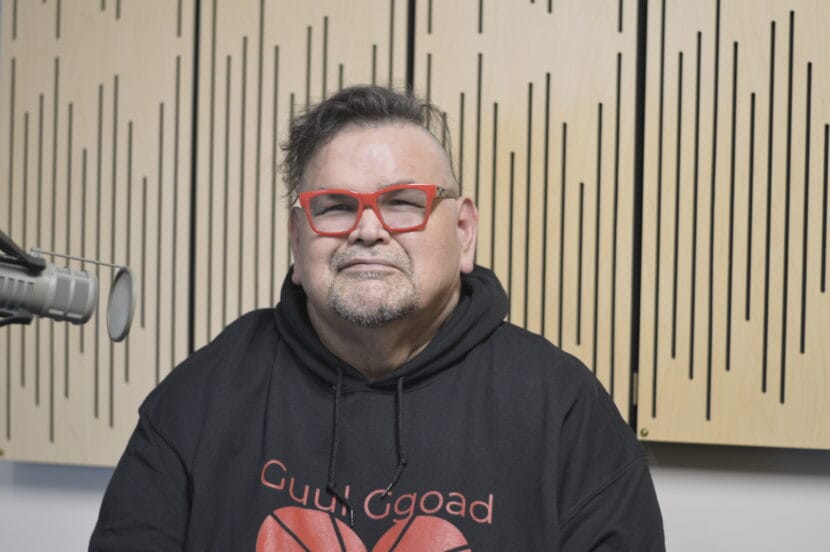This is Tongass Voices, a series from KTOO sharing weekly perspectives from the homelands of the Áak’w Kwáan and beyond.
Shiggoap Alfie Price is Tsimshian, Lingít and Haida, and he was raised in a Tsimshian household. Today, he’s a language learner and teacher who believes in using the power of community to strengthen the language revitalization movement.
Price has studied all three Southeast Alaska Native languages, starting with Sm’álgyax – the Tsimshian language.
Listen:
This transcript has been lightly edited for clarity.
Listen to: Shiggoap’s Sm’álgyx introduction
Shiggoap Alfie Price: There’s a fellow that you probably know, Lyle James who speaks Lingít, X̱aat Kíl, Sm’álgyx, among others. And before I started actively learning, he would greet me at the store or what have you, and in Sm’álgyx, and I certainly knew what he was saying, but I could not answer him. And I was a little bit embarrassed that this Lingít man was using my language and I couldn’t converse with him.
Shiggoap dee waayu. My name is Shiggoap which means wave-maker.
I started learning Sm’álgyx because it’s the one I grew up hearing. And I know people, I know family and friends who want to learn. So that’s why I started.
Also, I had some prompts from my mom, who, in her last few years, she started learning our language and teaching it to children. She was a guidance counselor at elementary school in Metlakatla. And so I felt encouraged. And, you know, I wish I had started earlier when she was still around so I could talk to her on the phone, or what have you or FaceTime.
I was asked to be a moderator or what have you at Celebration to introduce the groups, and I decided that I wanted to be able to introduce myself in all three languages. And so I set out to do that.
And they’re very different. You would think, here in Southeast Alaska, where we’re so geographically close, that our languages would be similar, but they’re really not. All three are very, very different. Sentence structure is way different. And most of the sounds are different.
So there’s a couple of years where I was attending classes in all three languages and tried really hard to be able to at least have the basics down where I could greet somebody in these languages, introduce myself, talk about the weather.
It’s pretty fun, too, when you find crossover. It’s like, in X̱aat Kíl, when we greet each other, we have a word that means like, “hey” or “hi.” We say “Ja!” So whenever I see my fellow X̱aat Kíl speakers, we say “Ja! Hello my friend!”
And then I was in a headstart classroom fixing computers one day, and they had posters on the wall of Lingít words, and one of them was a lady holding your finger up to her mouth, like saying “shhh.” And it said, “Ja!”, and I just, like cracked up because, you know, maybe Lingít speakers would see us X̱aat Kíl telling each other politely to shut up when we see each other.
I think one of my very favorite phrases in X̱aat Kíl is — it’s parting greeting, “Díi gwíi hl sdíihl.” And it means return to me. And that’s just a really sweet, sweet way to part with a friend.
Our Sm’álgyx group, we met in person every Saturday. And then when the pandemic hit us, we had to stop meeting in person and switch to zoom. So we invited our social media contacts and followers to join us. And suddenly, we had this huge group of people who wanted to learn.
I’m not a trained teacher or linguist. I never thought I’d ever have to learn the difference between transitive and intransitive verbs, but here we are.
So we all know that our three languages are kind of in trouble. They might be considered endangered. So we definitely need more people to not just study them, but to use them every day at home, at the grocery store or what have you.
I think the most powerful reason to keep at it for me and a lot of my friends is how healing it is for us as individuals in our spirits to reconnect with these languages because we learn a lot from them. You get an understanding, an insight into the worldview of our ancestors — of the way they view the world, the way they deal with each other.
And there are a lot of lessons in our languages, that once you start internalizing them, and being able to use them, they can definitely guide your thinking, your priorities.
And they really restore, they’ve restored my sense of worth, of value. I know who I am today, where before I learned Sm’álgyx, I really didn’t.






